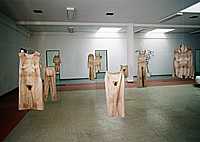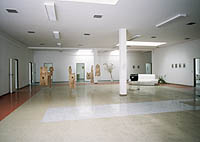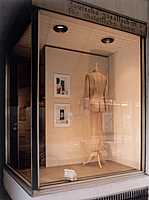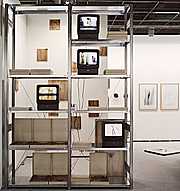The "Display" Installation forms the final stage of the series of events that made up the "Il Sarto Immortale" project. In this work, the material crystallizations that remain from the entire work process pieces of clothing from the collection, videos, photos, patterns, sketches, etc. are presented in different spatial contexts.
 |
 |
Display is conceived as a project that can be combined in various ways, and based on the different spatial conditions that reflect the specific venues of the presentation ritual in an artistic context (gallery rooms, museums, trade fairs, art clubs, etc) it continues to focus on the processes and mechanisms in the publishing and selling that occurs in the systems of fashion and art. The first realization of Display took place in Galerie Beckers in Darmstadt, in December 1997. The factory complex where the gallery is located was scheduled for demolition, and as a result, an entire section of the building became available for the gallery to use. The section was composed of a row of offices which surrounded a large hall. The naked walls, which revealed evidence of their past life, were interpreted in a special way by the objects of "Il Sarto Immortale": they "clothed" the shell of the empty rooms from within and thus indicated their approaching non-existence. On wire hangers hanging from the ceiling in a large central hall, nine pieces from the collection swayed, moved slightly by the wind. The pattern charts, samples of fabric, proofs and photos needed to put together the collection were scattered in the former offices adjacent to the hall, together with some articles taken from the previous events and installations.

At a later time, "Display" was set up in the "Kunstverein an der Finkenstrasse", an art club in Munich. The rooms of the Kunstverein are located in the city's luxury and shopping district, and they are architecturally structured like a traditional store: two large interior rooms are directly open to the street through a glass door and four display windows. The special location offered the possibility of not merely connecting the installation with the specific conditions of the exhibition room, but also to create a relationship with the location's social environment. So the clothes from the collection were put on typical display window mannequins and then exhibited in display windows that were prepared with back walls, together with videos, photos of the fashion show, and other props. "Anyone who wanders into Finkenstrasse while walking through the luxury district near Wittelsbacherplatz can experience a perfect irritation. In the display windows of the DG, pants suits, dresses, and costumes made of soft silk material are presented with the style of elegant fashion boutiques. But instead of colorful patterns, the clothes are printed with the image of a female body, precisely as though it was a second skin" (C. Gockel, Süddeutsche Zeitung 16 February 1998). The set up of the interior rooms was similar to the one in Darmstadt and offered the visitors who entered the exhibition room the possibility of getting a look at some of the past events.

Another showing of Display was prepared for the Frankfurt Art Fair in March 1998. In this form of the installation, the topic of selling skin is directly connected to standardized market forms and elements of the usual ritual "showing" used in art are combined with elements of department store presentations. The entire installation was compressed into the shelves of a store: the clothes folded and laid in cardboard boxes, the documentation and simulation videos were shown on typical presentation equipment used in department stores. Behind this equipment there were only canvas pictures hanging on the walls: modest objects for art exhibitions that could be sold easily fragments of the artist's skin, printed on material and used instead of the normal canvas.
// Alba D'Urbano
//

Main;
Archive() {
Esposizione Impraticabile();
Mare();
The Negated Room();
Hautnah;
Touch Me;
Stoffwechsel;
Il Sarto Immortale() {
}
Net-Works();
History();
Imprint;